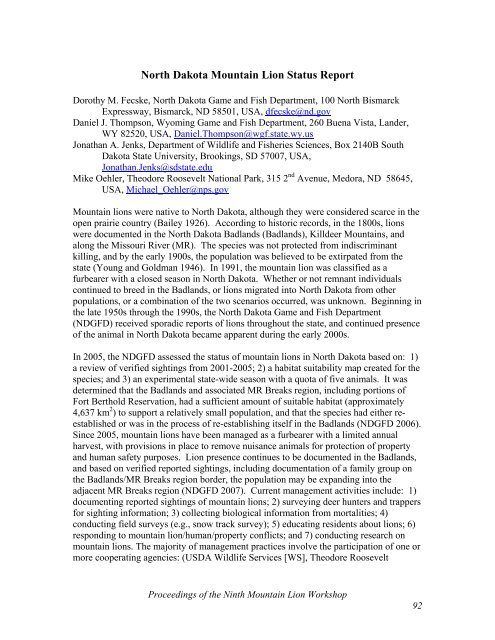Proceedings of the Ninth Mountain Lion Workshop - Carnivore ...
Proceedings of the Ninth Mountain Lion Workshop - Carnivore ...
Proceedings of the Ninth Mountain Lion Workshop - Carnivore ...
You also want an ePaper? Increase the reach of your titles
YUMPU automatically turns print PDFs into web optimized ePapers that Google loves.
North Dakota <strong>Mountain</strong> <strong>Lion</strong> Status Report<br />
Dorothy M. Fecske, North Dakota Game and Fish Department, 100 North Bismarck<br />
Expressway, Bismarck, ND 58501, USA, dfecske@nd.gov<br />
Daniel J. Thompson, Wyoming Game and Fish Department, 260 Buena Vista, Lander,<br />
WY 82520, USA, Daniel.Thompson@wgf.state.wy.us<br />
Jonathan A. Jenks, Department <strong>of</strong> Wildlife and Fisheries Sciences, Box 2140B South<br />
Dakota State University, Brookings, SD 57007, USA,<br />
Jonathan.Jenks@sdstate.edu<br />
Mike Oehler, Theodore Roosevelt National Park, 315 2 nd Avenue, Medora, ND 58645,<br />
USA, Michael_Oehler@nps.gov<br />
<strong>Mountain</strong> lions were native to North Dakota, although <strong>the</strong>y were considered scarce in <strong>the</strong><br />
open prairie country (Bailey 1926). According to historic records, in <strong>the</strong> 1800s, lions<br />
were documented in <strong>the</strong> North Dakota Badlands (Badlands), Killdeer <strong>Mountain</strong>s, and<br />
along <strong>the</strong> Missouri River (MR). The species was not protected from indiscriminant<br />
killing, and by <strong>the</strong> early 1900s, <strong>the</strong> population was believed to be extirpated from <strong>the</strong><br />
state (Young and Goldman 1946). In 1991, <strong>the</strong> mountain lion was classified as a<br />
furbearer with a closed season in North Dakota. Whe<strong>the</strong>r or not remnant individuals<br />
continued to breed in <strong>the</strong> Badlands, or lions migrated into North Dakota from o<strong>the</strong>r<br />
populations, or a combination <strong>of</strong> <strong>the</strong> two scenarios occurred, was unknown. Beginning in<br />
<strong>the</strong> late 1950s through <strong>the</strong> 1990s, <strong>the</strong> North Dakota Game and Fish Department<br />
(NDGFD) received sporadic reports <strong>of</strong> lions throughout <strong>the</strong> state, and continued presence<br />
<strong>of</strong> <strong>the</strong> animal in North Dakota became apparent during <strong>the</strong> early 2000s.<br />
In 2005, <strong>the</strong> NDGFD assessed <strong>the</strong> status <strong>of</strong> mountain lions in North Dakota based on: 1)<br />
a review <strong>of</strong> verified sightings from 2001-2005; 2) a habitat suitability map created for <strong>the</strong><br />
species; and 3) an experimental state-wide season with a quota <strong>of</strong> five animals. It was<br />
determined that <strong>the</strong> Badlands and associated MR Breaks region, including portions <strong>of</strong><br />
Fort Berthold Reservation, had a sufficient amount <strong>of</strong> suitable habitat (approximately<br />
4,637 km 2 ) to support a relatively small population, and that <strong>the</strong> species had ei<strong>the</strong>r reestablished<br />
or was in <strong>the</strong> process <strong>of</strong> re-establishing itself in <strong>the</strong> Badlands (NDGFD 2006).<br />
Since 2005, mountain lions have been managed as a furbearer with a limited annual<br />
harvest, with provisions in place to remove nuisance animals for protection <strong>of</strong> property<br />
and human safety purposes. <strong>Lion</strong> presence continues to be documented in <strong>the</strong> Badlands,<br />
and based on verified reported sightings, including documentation <strong>of</strong> a family group on<br />
<strong>the</strong> Badlands/MR Breaks region border, <strong>the</strong> population may be expanding into <strong>the</strong><br />
adjacent MR Breaks region (NDGFD 2007). Current management activities include: 1)<br />
documenting reported sightings <strong>of</strong> mountain lions; 2) surveying deer hunters and trappers<br />
for sighting information; 3) collecting biological information from mortalities; 4)<br />
conducting field surveys (e.g., snow track survey); 5) educating residents about lions; 6)<br />
responding to mountain lion/human/property conflicts; and 7) conducting research on<br />
mountain lions. The majority <strong>of</strong> management practices involve <strong>the</strong> participation <strong>of</strong> one or<br />
more cooperating agencies: (USDA Wildlife Services [WS], Theodore Roosevelt<br />
<strong>Proceedings</strong> <strong>of</strong> <strong>the</strong> <strong>Ninth</strong> <strong>Mountain</strong> <strong>Lion</strong> <strong>Workshop</strong><br />
92
















